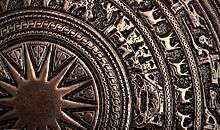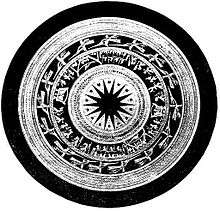Đông Sơn drums

Đông Sơn drums (also called Heger Type I drums) are bronze drums fabricated by the Đông Sơn culture in the Red River Delta of northern Vietnam. The drums were produced from about 600 BCE or earlier until the third century CE and are one of the culture's finest examples of metalworking.
The drums, cast in bronze using the lost-wax casting method are up to a meter in height and weigh up to 100 kilograms (220 lb). Đông Sơn drums were apparently both musical instruments and cult objects. They are decorated with geometric patterns, scenes of daily life and war, animals and birds, and boats. The latter alludes to the importance of trade to the culture in which they were made, and the drums themselves became objects of trade and heirlooms. More than 200 have been found, across an area from eastern Indonesia to Vietnam and parts of Southern China.[1]
History
The earliest drum found in 1976 existed 2700 years ago in Wangjiaba in Yunnan Chuxiong Yi Autonomous Prefecture China. It is classified into the bigger and heavier Yue drums including the Dong Son drums, and the Dian drums, into 8 subtypes, purported to be invented by Ma Yuan and Zhuge Liang. But the Book of the Later Han said Ma melt the bronze drums seized from the rebel Lạc Việt in Jiaozhi into horse.
The discovery of Đông Sơn drums in New Guinea, is seen as proof of trade connections - spanning at least the past thousand years - between this region and the technologically advanced societies of Java and China.[2]
In 1902, a collection of 165 large bronze drums was published by F. Heger, who subdivided them into a classification of four types.[3]
Appearances

The drums have a symmetrical appearance with three parts:
- the barrel (upper body)
- the head (top part)
- the leg (bottom part)
The patterns on drums bear a realistic style and show stilted houses, dancing people, people pounding rice, beating drums and sailing, together with animal and birds. The scenes depict daily life of ancient Viet and reflect the artistic talent and mind. The drums were used as musical instruments in festivals, such as prayers for rain, for good harvest and rituals, such as weddings and funerals, as well as command in army. They were also used as funerary objects and symbol of power of tribe leaders.
Classification
The Heger 1 drums of the Dong Son culture were classified and divided into five groups by the Vietnamese scholar Pham Huy Thong in 1990, a division that implied a chronological succession. The earliest, group A, comprisees a set of large and intricated decorated drums. Group B consists of a smaller drums which almost universally have a group of waterbirds in flight as their key motif on the tympanum and the mantle designs. Group C has a central panel on the tympanum made up of a row of plumed warriors placed inside another panel of waterbirds in flight. Toads line the tympanum's edge while the mantle was decorated with either patterns involving boats or geometric patterns.[3]
Notable drums
Ngoc Lu

The Ngọc Lũ drum is regarded as the most important of the Đông Sơn drums. The drum was accidentally discovered in 1893 in Hà Nam Province, southeast of Hanoi, rather than during a planned expedition. In contrast to most other drums of the Đông Sơn, the drumhead bears three concentric panels depicting animals or humans interleaved with bands of geometric or circular patterns. The innermost panel appears to be a self-referencing depiction, as it is decorated with pictures of humans who appear to be performing a ceremony involving the drums themselves. Other musical instruments and rice growing and harvesting activities are also shown. The two outer panels are decorated with scenes of deer, hornbills and crane egrets.[4]
Hoàng Ha
The Hoàng Ha drum is a notable Đông Sơn drum.[5] It was discovered in Hòa Bình Province in 1937 near the village of Hoàng Ha, with an outer panel of crane egrets and an inner panel which shows a procession similar to that described in the Ngọc Lũ drum, the most famous of the Đông Sơn drums.[5] It depicts four feathered men are depicted walking in a line, brandishing spears, with two musicians in tow. A person is depicted standing under the eaves of a house, beating a drum while the rice fields are unattended, allowing a bird to eat the rice that was intended for threshing. The boats depicted on the mantle of the drum are very similar, with an analogous cleft prow, archer standing on raised platform and a drum. However, the drum is different from the Ngoc Lu drum in that the animal is absent.[5]
Co Loa

The Cổ Loa drum is a notable specimen[5] showing a procession similar to that described in the Ngọc Lũ drum. The drum only has two warriors with spears, in contrast to that of the Ngọc Lũ drum. Another difference is that the ensemble of percussionists consists of three drummers, with one drum lying under the eaves of the house. Meanwhile, an extra person is depicted in the rice threshing process. The person has long hair and is winnowing grain into a bowl. The percussion ensemble is also depicted differently in that the drummers are not all drumming in synchronisation. Two of the drummers are depicted making contact with the drum, while the other two drummers have their batons in the raised position.[5]
Song Da
The Song Da drum is a notable specimen discovered in Ha Son Binh in the 19th century.[6] The drum shows a procession similar to that described in the Ngọc Lũ drum. This drum varies in that it depicts four sets of men in procession with feathered headgear, rather than two. Also, each set comprises three or four people none of whom appear to be armed. The posture of the men was interpreted as that they were participating in a dance rather than a military ceremony. In this drum, only one pair of people are depicted as threshing rice, and there is no cymbal player. However, the general motifs, such as the boats on the mantle, remain in place.[6]
Others
The Quang Xuong drum from Thanh Hóa Province is another specimen, which is believed to be possibly later in origin. However, the drum is smaller and the images are harder to interpret.[3]
Large drums found in northern Vietnam were generally in the minority, as most drums have simple decorations with fewer representations of people. The Ban Thom drum has only an inner panel with four houses and plumed humans standing alone or in couples.[3]
Modern customs
Zhuang people in Yunnan practice ningdong wine, ningdong music, etc. The ningdongs used by them have same decoration with Dong Son drums.[7]
See also
Notes
- ↑ Heidhues, Mary Somers (2000). Southeast Asia: A Concise History. London: Thames and Hudson. pp. 19–20.
- ↑ Diamond, Jared (1997). Guns, Germs, and Steel - The Fate of Human Societies. New York: W. W. Norton & Co. p. 307. ISBN 0-393-03891-2.
- 1 2 3 4 Higham, p. 128.
- ↑ Higham, p. 124.
- 1 2 3 4 5 Higham, p. 126.
- 1 2 Higham, p. 127.
- ↑ "Ningdong". Ndei Lai Biengz Raeuz. Season 1. CCTV. External link in
|title=(help)
References
- Higham, Charles (1996). The Bronze Age of Southeast Asia. Cambridge World Archaeology. ISBN 0-521-56505-7.
External links
| Wikimedia Commons has media related to Dong Son bronze drums. |
- The Present Echoes of the Ancient Bronze Drum by Han Xiaorong (University of Hawaii)
- Meaning of the Ngoc Lu bronze drum's surface
- Dong Son culture(Photo collection)
- Page at the Metropolitan Museum of Art
| ||||||||||
| ||||||||||||||||||
